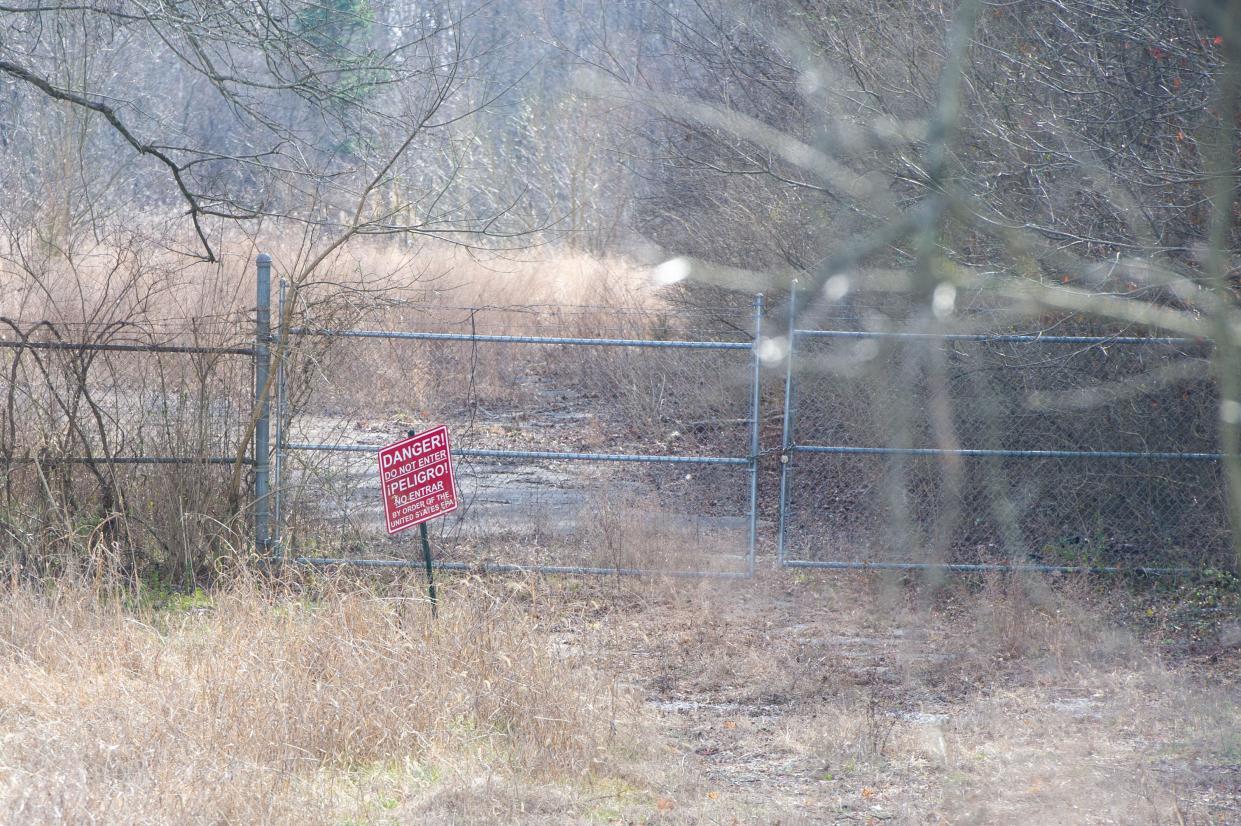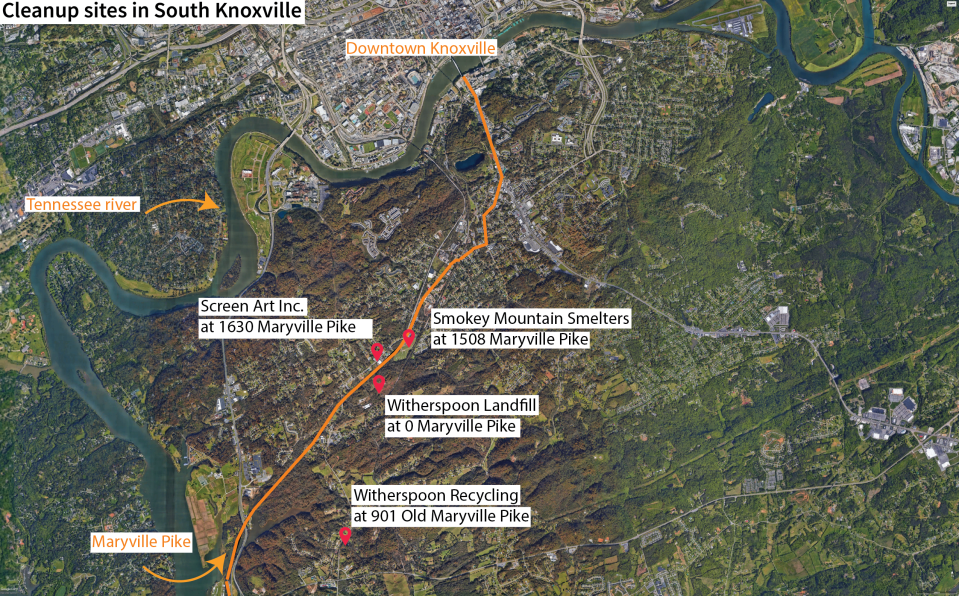EPA plans cleanup of Superfund site. Neighbors ask, what about others in South Knoxville?

(Correction: An earlier version of this article included photos that were not of the Smokey Mountain Smelters Superfund site, but of a neighboring property. The correct property is pictured above. We regret the error.)
As the Environmental Protection Agency moves ahead with the long process of cleanup of a Superfund site in South Knoxville, neighbors recently quizzed representatives about the status of other contaminated properties that appear on the state’s cleanup list.
Vestal neighborhood residents peppered EPA representatives with questions last week during a session to explain the cleanup of the Smokey Mountain Smelters Superfund site, asking for assurances the process would protect them in the years to come and raising questions about other contaminated sites nearby.
Just across the river from downtown, the Smokey Mountain Smelters site is within 75 feet of Montgomery Village, an apartment complex that includes rentals for lower-income residents. And nearby are three other contaminated sites, according to a Tennessee Department of Environment and Conservation database. Those sites are mostly within the 37920 ZIP code, home to 41,826 people, according to Census Reporter.

Here’s an update on on the EPA’s actions and the concerns raised by community members:
How much will the Smokey Mountain Smelters cleanup cost?
This stage of the cleanup will cost about $3.1 million for contractor funding, which will come from the Bipartisan Infrastructure Law.
The site already has cost about $9 million in prior cleanup activities, which involved the EPA reducing exposure and “off site migration” of contaminants. Earlier work included demolishing a remaining building, disposing of the debris off-site and capping other waste on-site in the interim, Peter Johnson, the site’s remedial action manager for the EPA, said.
More: EPA set to clean up Smokey Mountain Smelters Superfund site south of downtown Knoxville
Why is groundwater a concern for the community, EPA and TDEC?
The EPA previously has found contaminants including aluminum and heavy metals such as arsenic, lead, mercury and cadmium that exceeded “maximum contaminant levels” in the groundwater underneath the Smelters site, according to the EPA’s record of decision.Contaminated groundwater poses two threats to a community. In the first instance, anyone who uses well water and lives near a contaminated site could have their water contaminated if the groundwater migrates from underneath the property.
At the Smelters site, neighbors living nearby are on city water, meaning their drinking water doesn’t come from wells. However, at the public meeting on Feb. 13, a resident mentioned that neighbors could be using well water for other purposes, and they would like to know whether there are parameters for safety for those operations.
The interim cap that EPA installed appears to be working in preventing stormwater from penetrating the current landfill. Some of the wells EPA looked at in recent years appeared to be dry and some of the wells in lower areas from the landfill had greatly reduced concentration of contaminants in the groundwater, Johnson said.
The second risk is if the existing contamination were not addressed, the contaminants at the Smelters site could migrate to the surface water in the Tennessee River. This could compromise water quality for fishing and potentially for drinking since there are water intake locations downstream from the site, Lee Barron, regulatory project manager for TDEC, said after the press event last week.
The EPA plans to inject a fungicide into selected groundwater locations on the site to get rid of any existing groundwater contaminants, according to EPA’s remedial action fact sheet. The injections adjust the pH to be more neutral and less acidic. The process uses bacteria, which may reduce the contaminants and/or also convert dissolved metals in the water to a solid form, which could then be filtered out.
What will a cap over the on-site waste do?
To prevent future contamination of groundwater, the EPA plans to put an engineered cap - made up of six inches of topsoil, 18 inches of clay and a series of liners - over the waste that will be left on-site, Johnson said. That cap should prevent stormwater from penetrating the waste and bringing more contaminants into the groundwater.Multiple community members voiced concerns and questions over this plan. While the cap would prevent stormwater from getting in, it will need monitoring and maintenance.Additionally, the cap only prevents water from getting in from the top. One community member wanted to know what would happen if the water table were to rise due to heavy rain and the groundwater were to meet the buried waste, which will be left unlined as it is an existing landfill. Johnson said liners won’t surround the waste.
Johnson told residents that while the groundwater table can rise, the contamination has primarily been detected on the site, and the monitoring wells that are located on the edges of the property to track movement of contaminants in the groundwater had low to non-detectable concentrations of contaminants.
This indicates that the contamination is not at risk of moving to groundwater underneath other properties. The groundwater fungicide injections will target the remaining contamination.
More EPA news:EPA rule prompted by Kingston coal ash spill might be revised to include older landfills
What will happen to the Smokey Mountain Smelters property after cleanup?
Since waste will be left capped at this property, whoever purchases or owns the 13-acre Smelters site after the cleanup will have to “preserve” the cap. No water supply wells will be allowed, and there will be annual inspections of the site to ensure any future owner upholds their end of the bargain, Johnsons said.
The site will have a review every five years as part of Superfund law that regulates cases where “hazardous substances remain on site above levels that permit unlimited use and unrestricted exposure… EPA retains responsibility for determining the protectiveness of the remedy.”
While the five-year review requirement and classification of the site might inspire some confidence that the site will not only be kept safe but will be reused, Vestal residents wanted to know more about how the EPA would ensure future owners wouldn’t undo the safety work done at the site.
“EPA is cleaning it up and we are going to require restrictive covenants to be placed in the records that run with that land,” an EPA official told residents at the public meeting.
Residents also asked whether there would be public education about the health risks at the site. Johnson responded that he had been in contact with the Tennessee Department of Public Health and was told a health assessment of the site had not been done because the emergency action the EPA did at the site had “remediated the issue.”
At the press event, officials said the future use of the site has “yet to be determined,” but mentioned they’ve previously received proposals for a transit hub and a grocery store. The property has a railroad track on either side, which could make it attractive to industrial buyers.
TDEC Deputy Commissioner Greg Young said there could be a public review process for future use after the public risk at the site has been mitigated. Young said he anticipated “significant public engagement and involvement as a part of that process.”
After remediation, the site could have industrial or commercial use.
For Subscribers:14 years after TVA's Kingston coal ash spill, workers' families might never be made whole
What happened to the previous owners?
Superfund law requires polluters of contaminated sites to pay for the cleanup; if they can’t be forced to, funds are provided to the EPA to do the cleanup. To clean up this South Knoxville site, the federal government has had to foot the bill with funding from programs such as the Bipartisan Infrastructure Law.A Department of Justice investigation and negotiations with the responsible parties for the Smelters site were completed, and it was decided that the funds for the cleanup would come from the federal government, according to the EPA.
Vestal residents were very interested in knowing whether the previous owners of the property would be held accountable for abandoning the site in such hazardous conditions and what could be done to prevent any owners from doing the same thing in the future.
Residents were heavily interested in the future care of the site, since historically they’ve had neighboring properties that have required evaluation and/or remediation from the EPA and TDEC.
What other sites in South Knox are on EPA and TDEC cleanup lists?
TDEC lists three other cleanup sites off Maryville Pike in its Division of Remediation dataviewer:
Witherspoon Recycling, at 901 Old Maryville Pike, was referred to the Tennessee’s Attorney General’s Office, according to TDEC. There is an injunction attached to the property that prohibits the owner and anyone working with the owner “from accessing the site, conducting any activity on the site, or selling/transferring the site,” Elizabeth Lane, a spokesperson for the state’s Attorney General’s Office said in an email to Knox News.
Screen Art Inc, at 1630 Maryville Pike, was referred to the Tennessee Attorney General’s Office, according to TDEC. The site is the subject of negotiations with the Department of Energy, and the state AG's office cannot provide an update, Lane said.
Witherspoon Landfill has a damaged cap and "TDEC is working to resolve the situation," according to TDEC.
All these sites are within about a mile of each other in South Knoxville.
Other neighboring sites were previously evaluated by the EPA or TDEC:
The Candora Road Drum site had drums which were remediated by a state contractor. The site was “closed out” in 1997, according to TDEC.
Witherspoon Candora, at 4420 Candora Ave., was pre-screened by the EPA but did not meet the criteria for placement on the EPA’s Superfund National Priorities List. The site was “closed out” in 2012, according to TDEC.
The Berry Road Dump site was evaluated for its groundwater, soil, sediment and water samples, which showed no exceedance, therefore “No further action was determined and the site was closed out in 1996,” according to TDEC.
Witherspoon Candora Avenue, at 4430 Candora Ave., was evaluated but did not meet the criteria to be considered an EPA Superfund site. TDEC and EPA are not involved with the property at this time, according to the EPA.
Anila Yoganathan is a Knox News investigative reporter. You can contact her at anila.yoganathan@knoxnews.com, and follow her on Twitter @AnilaYoganathan. Enjoy exclusive content and premium perks while supporting strong local journalism by subscribing at knoxnews.com/subscribe.
This article originally appeared on Knoxville News Sentinel: EPA plans Superfund site cleanup. Neighbors ask, what about others?
